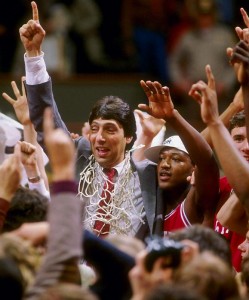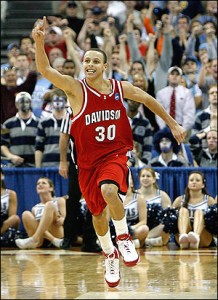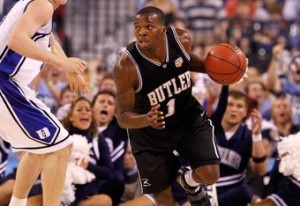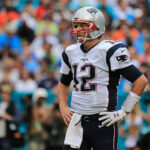Top 10 Most Memorable NCAA Tournament Runs
Welcome to the third and final part of the 50 most memorable NCAA tournament runs since 1979.
Today, we look at the best of the best, the 10 greatest tournament runs since the NCAA began to use seeding back in 1979.
10. 1987 Providence
Before the 1986-87 season, the NCAA adopted a three-point line for division I basketball.
The three-pointer became the focal point of Providence’s Final Four run, the first team Rick Pitino took the Final Four.
The sixth-seeded Friars knocked off UAB in the first round, then held off #14 seed Austin Peay with an overtime victory in the second round to advance to the Sweet 16, where the team drained 14 off 22 three-pointers to upset second-seeded Alabama 103-82 to reach the Southeast Regional Final and a date with top-seed and conference rival, Georgetown.
Expecting a barrage of three-pointers, the Hoyas were stunned when Providence went to an inside game and shot only eight three-pointers as the Friars surprised Georgetown 88-73 to make it to the Final Four for the first time since 1973.
However, the Friars could not overcome another Big East team in their national semifinal, as they were defeated by the Syracuse Orangemen, 77-63.
9. 1989 Michigan
Although there were ranked 3rd in the preseason poll and were ranked throughout the season, the Michigan Wolverines’ championship run in 1989 was unexpected because of their coaching situation.
On March 15th, just two days before Michigan’s first tournament game, head coach Bill Frieder announced that he would leave after the tournament was over to become the new head coach at Arizona State.
But athletic director Bo Schembechler relieved Frieder of his duties immediately, saying “A Michigan man will coach Michigan” and promoted assistant head coach Steve Fisher to interim head coach.
All the Wolverines did under Fisher was win all six games and the school’s first national championship in basketball, thanks to the three-point shooting of Glen Rice and point guard Rumeal Robinson.
Rice averaged 30.7 points per game as 3rd seeded Michigan knocked off Xavier, South Alabama, North Carolina, and Virginia to win the Southeast regional and make the trip to the Final Four.
Then, Michigan knocked off Illinois 83-81 in their national semifinal when Sean Higgins rebounded a missed shot and puts it back in for the game-winning basket with two seconds to go, sending the Wolverines to the title game to face Seton Hall.
Robinson made the game-winning free throws with three seconds left in overtime to give Michigan an 80-79 victory, the national title, and the head coaching job for Fisher, who stayed as the Michigan head coach until 1997.
8. 2008 Davidson
Guard Stephen Curry, son of former NBA player Del Curry, became an overnight sensation with his performance in the Davidson Wildcats’ run to the Elite Eight.
Curry averaged 32 points per game in four games as the 10th seeded Wildcats defeated Gonzaga in the first round, thanks to 40 points from Curry, followed by a comeback win over Georgetown where Curry scored 25 of Davidson’s last 30 points, and poured in 33 points in an easy 73-56 win over Wisconsin in the Sweet 16.
But Curry could not get the Wildcats despite his 25 points in a 59-57 loss to eventual national champion Kansas in the Midwest Regional Final.
7. 1988 Kansas
Even though they had player of the year in Danny Manning, the Kansas Jayhawks were not expected to do much in the NCAA tournament as they were a #6 seed in the Midwest region after a 17-11 season.
Manning carried the load in the Jayhawks’ first round victory against Xavier with 24 points, then made the go-ahead basket with 38 seconds left in their 61-58 second round win over upset-minded Murray State to get out of the first weekend.
Manning continued his great play in the Sweet 16 with a 38-point performance in a 77-64 win over Vanderbilt, then helped lead the Jayhawks to a 71-58 win over intrastate rival Kansas State, to advance to the Final Four back in Kansas City.
After a 25-point and 10-rebound performance in the Jayhawks’ 66-59 win over Duke in the national semifinals, Manning put together his best performance of the tournament as he scored 31 points, grabbed 18 rebounds, and made five steals to lead Kansas to a 83-79 upset over Big 8 conference rival Oklahoma for the school’s first national championship since 1952.
The team is now immortalized as “Danny and the Miracles”.
6. 1990 Loyola Marymount
Even though they played in the West Coast Conference, the Loyola Marymount Lions were considered a legitimate threat for the NCAA championship in 1990 because of their fast break offense that averaged 122.4 points per game.
But tragedy struck in the West Coast Conference tournament, when all-American forward Hank Gathers collapsed in the middle of the floor, and died during the Lions’ semifinal against Portland.
The conference cancelled the rest of the tournament and awarded the automatic bid to the Lions for winning the regular season title, but Loyola was seeded 11th in the West Regional and was not expected to do much with the black cloud of Gathers’ death hanging around them.
However, the Lions put together perhaps the most emotional run in NCAA tournament history, as they made it all the way to the Elite Eight, as Bo Kimble and his left-handed free throws in tribute to Gathers, inspired the country.
Kimble scored 45 points as Loyola defeated New Mexico State 111-92 in the first round, then poured in 37 points and got help from Jeff Fryer who made 11 three-pointers as the Lions stunned defending national champion Michigan 149-115 in the highest scoring game in tournament history.
In the Sweet 16, the Lions faced off with Alabama, who ran the shot clock on almost every offensive possession in hopes of slowing down Loyola.
It did slow the game down, but the Lions came away with a 62-60 win and a trip to the Elite Eight.
Sadly for the Lions, their storybook run ended at the hands of eventual national champion UNLV in a 131-101 defeat.
5. 2010 Butler
The Butler Bulldogs almost pulled off the greatest moment in tournament history when their last-second buzzer beater bounced off the rim in the national title game against Duke.
As a #5 seed in the West region, Butler defeated double-digit seeds UTEP and Murray State to advance to the Sweet 16, where the Bulldogs knocked off the top seed, Syracuse, and then beat second-seeded Kansas State to reach the Final Four in their hometown of Indianapolis.
In the national semifinals, Butler pulled off their third straight upset, a 52-50 win over Michigan State to advance to the national championship game, where they faced off with the Duke Blue Devils.
The game was tight throughout and the Bulldogs trailed 60-59 with 36 seconds remaining and a chance to take the lead.
But Gordon Haywood missed a fade-away jumper and Butler was forced to foul center Greg Zoubek with 3.6 seconds to go.
Zoubek made the first free throw, but missed the second one intentionally, which was rebounded by Haywood who got off a desperation shot from half-court as time expired, that hit the backboard and bounced off the rim.
If it had gone in, Butler would have won the game and the national title, but instead had to watch the Blue Devils celebrate the 61-59 win and the national championship.
4. 1986 LSU
Though they were a #11 seed, the LSU Tigers were thankful just to be in the tournament after a season of injuries, illnesses, and suspensions to finish with a 22-11 record and a 9-9 conference record.
The Tigers caught a break as they got to play their first and second round games at home in Baton Rouge, since it was not prohibited for a team to play tournament games on its home floor.
Still, the Tigers had to earn their way to the second weekend as they defeated Purdue in double overtime in the first round, and then knocked off third-seeded Memphis 83-81 with a game-winning jumper by Anthony Wilson as time expired.
The Southeast Regional moved to Atlanta where the Tigers had to face off with second-seeded Georgia Tech, in their home city.
But the Bayou Bengals came through again as they dispatched of the Yellow Jackets, 70-64, to advance to the Elite Eight where they faced with #1 seed Kentucky, a team that had defeated LSU three times in the season.
But it would not be a fourth time as LSU defeated Kentucky 59-57, to become the lowest seed to reach the Final Four, a feat equaled by George Mason in 2006.
The Tigers would fall in the national semifinals to eventual national champion Louisville, 88-77.
3. 1985 Villanova
While most fans remember the Villanova Wildcats upset over Georgetown in the title game, they do not remember the remarkable way the Wildcats got to the title game.
1985 was the first year that the tournament field had 64 teams and Villanova would likely have been out if it stayed at 48 teams, as the Wildcats finished with a 19-10 record in the regular season.
But with the field expanded, the Wildcats earned a #8 seed in the Southeast Regional, yet had to face Dayton in Dayton, Ohio for their first round game.
However, the Wildcats prevailed with a 51-49 win over the Flyers, to advance to the second round where they faced with top-seed and #2 team ranked in the country, Michigan.
The Wildcats stunned Michigan 59-55 and advanced to the Sweet 16, where they faced off with Len Bias and Maryland.
After a 46-43 win over the Terps, the Wildcats faced the second-seeded North Carolina Tar Heels in the regional final.
Once again, Villanova pulled off another upset as they defeated the Tar Heels 56-43 to make to be one of three Big East teams to reach the Final Four that year.
In the national semifinals, the Wildcats dispatched of the non-Big East team in the Final Four, Memphis, 52-45 to go to the national championship game where they faced off with defending national champion and the #1 team in the country, Georgetown.
The Wildcats were heavy underdogs against the Hoyas, but they played the game of their lives as the team made 22 of 28 shots in the game, nine of 10 in the second half, to defeat Georgetown 66-64 and win the national championship.
2. 2006 George Mason

George Mason defeated traditional powers Michigan State, UNC and Connecticut during their run to the 2006 Final Four.
Ever since their Final Four run, college basketball fans and experts have been looking for the “next George Mason”, a mid-major team who could came out of nowhere and crashes the party that is known as the Final Four.
That is what the George Mason Patriots, out of the Colonial Athletic Association, did in 2006 with their run as a #11 seed in the East region.
The Patriots started off their run with a first round win over Michigan State, a Final Four team from the previous year, before moving on to the second round where they faced off with defending national champion North Carolina.
It appeared that the Tar Heels would run George Mason out of the arena as they jumped out to a 16-2 lead, but the Patriots came back for a shocking 65-60 win to move onto the Sweet 16, where they would play in Washington D.C., just 20 miles from their campus.
After a victory over Wichita State, the Patriots faced off with #1 seed and pre-tournament favorite UConn in the regional final.
George Mason overcame a 43-34 halftime deficit to take a 74-70 lead with 10 seconds remaining, but a Marcus Williams lay-up, a missed free throw by Patriots guard Tony Skinn, and a lay-up by Denham Brown sent the game into overtime.
But once again the Patriots refused to back down and after Brown missed a potential game-winning three pointer at the buzzer, George Mason was in the Final Four with an 86-84 win.
Even though their run came to an end the following week with a loss to Florida, the George Mason Patriots put their place in college basketball lore with their incredible run.
1. 1983 N.C. State
But when college basketball fans and experts think of the Cinderella run in the tournament, they often think of Jim Valvano and the 1983 N.C. State Wolfpack.
The “Cardiac Pack” pulled off a series of upset and comeback wins to stun the college basketball world and win the 1983 NCAA championship.
The Wolfpack entered the 1983 NCAA tournament with a 20-10 by having won the ACC tournament to win the conference’s automatic bid and earn a #6 seed in the West regional.
It appeared that the Wolfpack would not even get out of the first round as they trailed Pepperdine by six points with 59 seconds to go in overtime.
But Valvano instructed his team to foul the Pepperdine players and a few missed free throws, the Wolfpack were able to tie the game when Cozell McQueen made an eight-footer to force a second overtime where the Wolfpack prevailed, 69-67.
In the second round, N.C. State trailed UNLV by 12 points with 12 minutes to play, but once again come from behind and pulled out a 71-70 win when Thurl Bailey made the game-winning basket with four seconds to play and send the Wolfpack to the Sweet 16
After an easy 75-56 win over Utah, the Wolfpack faced #1 seed Virginia and player of the year Ralph Sampson.
Once again the Wolfpack fell behind and once again the Wolfpack as they outscored the Cavaliers 10-4 in the last five minutes of the game for a 63-62 win as Lorenzo Charles made the go-ahead free throws with 23 seconds to go and the Cavaliers missed two shots in the final seconds to send N.C. State to the Final Four.
N.C. State defeated Georgia 67-60 in their national semifinal to advance to the national championship game where they faced off the Houston Cougars, #1 team and winners of 26 games in a row.
N. C. State jumped out to a 33-25 halftime lead, but the “Phi Slamma Jamma” came back with a 17-2 run to start the second half and held a 42-35 with 10:04 to play.
But like they had throughout the tournament, the Wolfpack came back and tied the game and tied the game at 52-52, with a chance to win the game after Houston’s Alvin Franklin missed a front end of a one-and-one with 1:05 left.
N.C. State held for the last shot but the best shot they could get off was a desperation shot by Derrick Whittenberg from 35 feet out with three seconds to go.
The shot was going to be an air ball until Lorenzo Charles caught the air ball and slammed it for a game-winning slam dunk as time expired, giving the Wolfpack a 54-52 win and the national championship.
With their series of dramatic comebacks and their shocking win over the “Phi Slamma Jamma” to win it all, the 1983 N.C. State Wolfpack’s tournament run is the greatest NCAA tournament run of all time.















